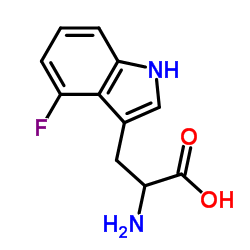Distortion of the catalytic domain of tissue-type plasminogen activator by plasminogen activator inhibitor-1 coincides with the formation of stable serpin-proteinase complexes.
Michel J Perron, Grant E Blouse, Joseph D Shore
Index: J. Biol. Chem. 278(48) , 48197-203, (2003)
Full Text: HTML
Abstract
Plasminogen activator inhibitor-1 (PAI-1) is a typical member of the serpin family that kinetically traps its target proteinase as a covalent complex by distortion of the proteinase domain. Incorporation of the fluorescently silent 4-fluorotryptophan analog into PAI-1 permitted us to observe changes in the intrinsic tryptophan fluorescence of two-chain tissue-type plasminogen activator (tPA) and the proteinase domain of tPA during the inhibition reaction. We demonstrated three distinct conformational changes of the proteinase that occur during complex formation and distortion. A conformational change occurred during the initial formation of the non-covalent Michaelis complex followed by a large conformational change associated with the distortion of the proteinase catalytic domain that occurs concurrently with the formation of stable proteinase-inhibitor complexes. Following distortion, a very slow structural change occurs that may be involved in the stabilization or regulation of the trapped complex. Furthermore, by comparing the inhibition rates of two-chain tPA and the proteinase domain of tPA by PAI-1, we demonstrate that the accessory domains of tPA play a prominent role in the initial formation of the non-covalent Michaelis complex.
Related Compounds
| Structure | Name/CAS No. | Molecular Formula | Articles |
|---|---|---|---|
 |
4-Fluorotryptophan
CAS:25631-05-4 |
C11H11FN2O2 |
|
Fluorine-19 nuclear magnetic resonance spectroscopic study o...
1994-05-03 [Biochemistry 33(17) , 5238-45, (1994)] |
|
Atomic mutations at the single tryptophan residue of human r...
1999-08-17 [Biochemistry 38(33) , 10649-59, (1999)] |
|
Incorporation of tryptophan analogues into staphylococcal nu...
1998-06-23 [Biochemistry 37(25) , 8938-46, (1998)] |
|
Phosphorescence and optically detected magnetic resonance ch...
1998-06-23 [Biochemistry 37(25) , 8954-64, (1998)] |
|
Intracellular uptake and inhibitory activity of aromatic flu...
2008-09-01 [ChemMedChem 3 , 1449, (2008)] |